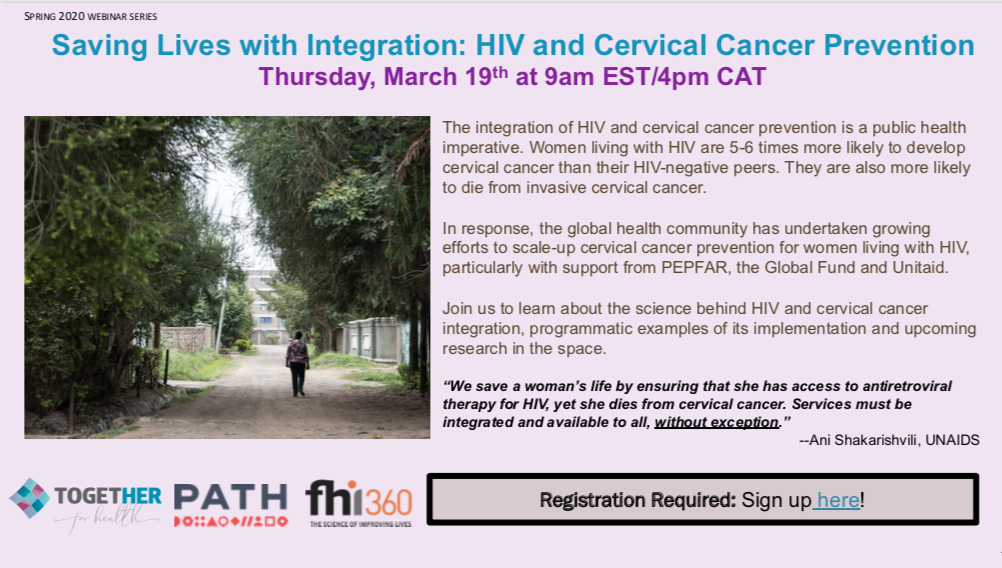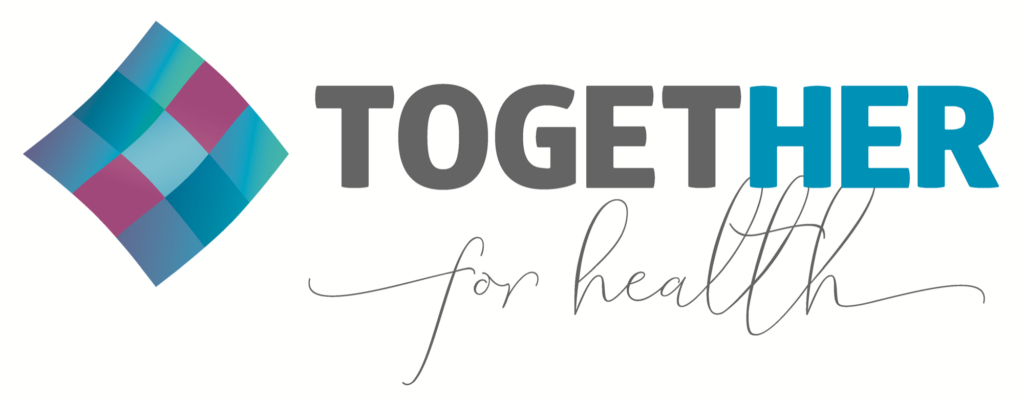Webinar on Integrating Cervical Cancer and HIV Programs
Women living with HIV are 5-6 times more likely to develop cervical cancer than their HIV-negative peers, and more likely to die from invasive cervical cancer. TogetHER for Health, PATH, and FHI360 presented a webinar on March 19, 2020 to help the global health community learn about the science behind HIV and cervical cancer program integration, programmatic examples of its implementation, and upcoming research in the space. View the recording and access the presentations below.
A robust question & answer session ended the event, but a few questions remained. We asked our three speakers to respond to participants' remaining questions, and posted their written answers below the video.
Additionally, check out TogetHER's fact sheet on the linkages between cervical cancer and HIV.
Presentations from this webinar:
Presenter: Dr. Chemtai Mungo, University of California, San Francisco (UCSF)
Title: Cervical Cancer & HIV: Intersecting Epidemics
Presenter: Dr. Emeka F Okechukwu, Director Technical, FHI 360, Tanzania
Title: HIV/Cervical Cancer Program Integration
Presenter: Dr. Kerry Thomson, PATH
Title: Optimizing Cervical Cancer Screening Among Women Living with HIV
Additional Q&A
Cervical Cancer & HIV: Intersecting Epidemics
Dr. Chemtai Mungo, MD, MPH
Q: The risk of dying in 2 years in HIV+ diagnosed with cervical cancer is unbelievably high, is this for treated or untreated women?
A: The risk of death unfortunately reflects women who have accessed or tried to access treatment. In the Uganda study (Wu et al, 2020), most women received cancer treatment (85% of HIV+ and 75% of HIV- negative women), though almost half who received radiotherapy did not complete the treatment (only 57% of HIV+ and 58% of HIV- women received adequate radiotherapy), reflecting challenges in accessing radiation treatment in these settings.In a study from Botswana, women received treatment as well (Dryden-Peterson et al, 2016)
Q: In the first presentation, the speaker talked about how CD4 T-cell count does not correlate with risk of cervical cancer. We currently ask women who have a CD4 count of less than 400 be screened annually. In light of the comment made by the speaker, should we be altering this statement at all?
A: The frequency of screening is guideline-dependent for different regions, often based on consensus and best evidence, and is often changing. Hence it’s best to adhere with local guidelines and keeping up with your local guidelines. Most guidelines recommend screening initially every 6 months, and then yearly for HIV+ women. Again, slightly different based on context. Most important for cervical cancer prevention among HIV+ women is to adequately follow-up any abnormal screening results, and if a woman is treated for precancer, to have adequate post-treatment surveillance for recurrence.
Q: Vaccination is primary prevention, why would HPV testing be considered as primary rather than secondary prevention?
A: HPV vaccination is the primary prevention for cervical cancer. However, for women who never got HPV vaccination, and acquire HPV, the WHO recommends HPV testing where available for cervical cancer screening. In this case of secondary prevention, we are testing for HPV infection because we know HPV infection is the cause of cervical cancer. This is why HPV testing is used as a screening test in secondary prevention.
HIV/Cervical Cancer Program Integration
Dr. Emeka F. Okechukwu
Q: Do the sites with the HIV cervical cancer screening project also have screening services for non-HIV positive clients? Not necessarily supported by this project?
A: Yes! There is usually decentralized screening in OPD & MCH service delivery points for non-HIV Positive women. Then those screened VIA-positive are taken to the service delivery point for cryotherapy
Q: 5% of VIA positivity rates among HIV+ sounds low, what Quality Assurance methods are built into your program?
A: The project follows the recommendations in the Tanzania national “Guideline of Quality Improvement for VIA Based Screening Approach”. It has performance standards and indicators covering key quality assurance areas including “Positivity Rate”. For instance, the standard for positivity rate is 5 – 10%, this is tracked by the project and facilities with positivity rate outside this range receive exploration and intensive technical assistance and mentorship to identify any potential underlying causes and to put corrective measure in place.
Q: Do you test women by both HPV test and VIA?
A: No. Only VIA at this time.
Q: Any movement towards HPV DNA testing for screening?
A: HPV DNA testing is an excellent approach, but its high cost may not make it a good public health approach in a resource limited setting such as Tanzania. Efforts are underway to reduce the price of DNA testing which would increase its feasibility in low-resource settings.
Q: What was the stakeholders' response to using VIA rather than PAP smear? Did this vary by level of care?
A: PAP Smear requires expertise that are not available in lower health facilities and is not ideal for public health approach in resource limited settings
Q: Has the program considered thermal ablation rather than cryotherapy given the issues with gas supply?
A: Thermal ablation is easier logistically but is not yet included Tanzania guidelines. We expect it is likely to be included in the next review/update. For now, the project is expected to leverage available treatment platforms. Thermal ablation will require more funding.
Q: Does PEPFAR support thermal ablation treatment of precancer?
A: Yes! It's in MER 2.4
Q: Does PEPFAR support treatment of those who test positive in screening, and is this support available in Nigeria?
A: Yes! But limited to cryotherapy, thermal ablation & LEEP. You may need to find out more about PEPFAR programming from the local team to assess availability in Nigeria. However, as referenced above, it is now one of the required reported indicators in PEPFAR MER 2.4
Q: As part of your outreach activities do you conduct community education, if so, how do you do that?
A: The outreach is targeted on HIV positive women currently on ARV treatment in peripheral HIV care & treatment health facilities (without cervical cancer services). So yes! During the morning health talk on each ART clinic day, the clients are educated on the need for cervical cancer services; then during adherence counselling session, the clients are further counselled and are offered the services with staggered appointment times on the day of the outreach to reduce ‘waiting time’. After the maximum number of clients are reached per day, the booking continues on the next outreach day which is usually twice a month. The project supports a team of trained personnel to visit these facilities on the outreach days to conduct VIA & cryotherapy.
Q: How sustainable are services beyond the funding for the study? How much of those great initiatives will continue beyond the life of the project with the same strength and thoroughness? What is the government support for the project?
A: Sustaining the program beyond this project will be challenging, however some activities could be supported in the health budget. This is why the project focuses on getting the government health authorities involved and engaged throughout the program. Regional & Council Health Management Teams (R/HMTs) are carried along in the implementation and monitoring of the program. Activities, though supported by the project, are included in the Council Health Plan. This engagement lays the foundation for ownership.
Q: I used to work on CaCx in Tanzania with Jhpiego and MaryRose Giattas. We helped RCHS develop a DHIS2 module for recording CaCx service delivery in Tanzania - is this still in use?
A: Yes! It’s still in use. However, DHIS 2 reports aggregated data for general population, though disaggregated by HIV status; it’s not helpful for longitudinal patient follow up and doesn’t show ART status.
Q: Will this project cover Nigeria?
A: Cervical cancer screening and treatment services may be available through PEPFAR programs. PEPFAR MER 2.4released in Sept 2019 requires HIV care & treatment projects to report on cervical cancer screening (CXCA_SCRN, p. 81) and cervical cancer treatment (CXCA_TX, p. 134).
Q: I think the top area of research is about scale. The Tanzania results are impressive (over 10,000 screened last quarter! Congratulations) but I feel a lot of focus has been on technology while the scale and rollout has lagged in terms of systematic learning.
A: Yes, I agree! Implementation science focusing on scale up & roll out should be emphasized
Optimizing Cervical Cancer Screening among Women Living with HIV
Dr. Kerry A. Thomson, PhD, MPH
Q: In your study are you able to obtain all of those screening tests (VIA, pap, HPV with genotyping, AVE, E6/E7, methylation) and compare them to each other and then also to a gold standard?
A: All women enrolled will be screened with all tests that are included in the final protocol. The current candidate tests are VIA, pap, HPV with genotyping, AVE, E6/E7, and methylation. Yes, an individual woman’s results on all of the included screening test will be compared. It is still under discussion what we will use as our gold standard. One option is for biopsy to be our gold standard. Women who have visible lesions will have biopsy, but we are still deciding about if / how to biopsy women who screen negative and/or do not have visible lesions. Four quadrant biopsy is one option for these women, but we need to be especially cautious and weigh the benefits and harms of biopsy among women living with HIV.
Q: Do we foresee vaccination becoming a part of the regular vaccination regimen like we do for other diseases?
A: Countries are at different stages of implementing HPV vaccination for primary prevention of HPV acquisition. In most countries these efforts focus on vaccinating adolescent girls, but some countries are including adolescent boys and older population as well. This resourcefrom PATH included maps and a table detailing which countries have adopted national-level implementation. In these countries, national-level routine immunization is part of the country’s expanded program on immunization (EPI).

